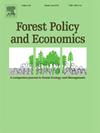森林部门工业衰退对区域经济和就业的影响:来自密歇根州锯木厂关闭的证据
IF 3.8
2区 农林科学
Q1 ECONOMICS
引用次数: 0
摘要
本研究调查了2019年至2023年期间密歇根州锯木厂进出的经济影响,这一时期的特点是该行业正在发生结构性变化,包括几家大型锯木厂的关闭和中小型锯木厂的开业。利用从密歇根州自然资源部(DNR)的工厂调查和密歇根州的社会会计矩阵(SAM)观察到的就业变化,我们应用基于就业的乘数分析来估计净锯木厂失业对全州经济的影响。结果表明,在此期间,由于锯木厂进出的净变化,只有273个直接工作岗位流失,但更广泛的连锁反应要大得多,约有820个工作岗位和2.11亿美元的产出损失。这些影响在伐木和运输等劳动密集型行业以及批发贸易和房地产等下游行业最为明显。调查结果凸显了锯木厂在地区供应链和各州劳动力市场中的核心作用,三分之二的失业发生在锯木厂以外。此外,该研究还为工厂周转如何影响当地经济提供了新的见解,并帮助国家机构确定哪些地区和行业最容易受到未来工厂关闭的影响,并更有效地分配经济发展资源或转型援助。本文章由计算机程序翻译,如有差异,请以英文原文为准。
Regional economic and employment impacts of industrial decline in the forest sector: Evidence from sawmill closures in Michigan
This study investigates the economic impact of sawmill entry and exits in Michigan between 2019 and 2023, a period marked by ongoing structural changes in the industry, including the closure of several large mills and the opening of smaller or mid-sized operations. Using observed employment changes from the Michigan Department of Natural Resources (DNR) mill survey and Michigan state's Social Accounting Matrix (SAM), we applied an employment-based multiplier analysis to estimate how net sawmill job losses affected the statewide economy. The results show that while only 273 direct jobs were lost due to net changes from sawmill entry and exit during this period, the broader ripple effects were much larger, approximately 820 jobs and $211 million in output loss. These effects were most pronounced in labor-intensive sectors such as logging and transportation, as well as in downstream sectors like wholesale trade and real estate. The findings highlight the central role of sawmills in regional supply chains and states labor markets, with two-thirds of job losses occurring outside the mills themselves. Further, this study contributes new insight into how mill turnover impacts local economies and helps state agencies identify which regions and industries are most vulnerable to future mill closures and allocate economic development resources or transition assistance more effectively.
求助全文
通过发布文献求助,成功后即可免费获取论文全文。
去求助
来源期刊

Forest Policy and Economics
农林科学-林学
CiteScore
9.00
自引率
7.50%
发文量
148
审稿时长
21.9 weeks
期刊介绍:
Forest Policy and Economics is a leading scientific journal that publishes peer-reviewed policy and economics research relating to forests, forested landscapes, forest-related industries, and other forest-relevant land uses. It also welcomes contributions from other social sciences and humanities perspectives that make clear theoretical, conceptual and methodological contributions to the existing state-of-the-art literature on forests and related land use systems. These disciplines include, but are not limited to, sociology, anthropology, human geography, history, jurisprudence, planning, development studies, and psychology research on forests. Forest Policy and Economics is global in scope and publishes multiple article types of high scientific standard. Acceptance for publication is subject to a double-blind peer-review process.
 求助内容:
求助内容: 应助结果提醒方式:
应助结果提醒方式:


